Authors: David Bordwell,Kristin Thompson
B0041VYHGW EBOK (151 page)
Segment 1
surprises us by beginning with a woman swinging in a garden
(
10.57
).
Yet the film’s title may lead us to notice the regular rhythm of the swinging and the puppetlike gestures as the woman repeatedly lifts her eyes and head, then lowers them, a fixed smile on her face. Certain abstract qualities already have become prominent. Suddenly, a rapid succession of images appears, passing too quickly for us to do any more than glimpse a hat, bottles, an abstract white triangle, and other objects. Next a woman’s mouth appears, smiling, then not smiling, then smiling again. The hat returns, then the smiling mouth again, then some spinning gears; then a shiny ball circles close to the camera. The woman in the swing returns but now upside down
(
10.58
).
This segment ends with the shiny ball, now swinging back and forth directly toward the camera, and we are invited to compare its movement with that of the woman in the swing. We are thus confirmed in our expectation that she is not a character but an object, like the bottle or the shiny ball. The same is true of that smiling mouth, which does not suggest an emotion as much as a regularly changing shape. Shapes of objects (a round hat, vertical bottles), direction of movement (the swing, the shiny ball), textures (the shininess of both the ball and the bottles), and the rhythms of the objects’ movements will be qualities that draw our attention.
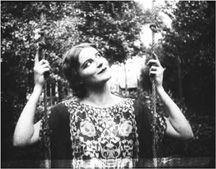
10.57 The opening shot of
Ballet mécanique
’s first segment.
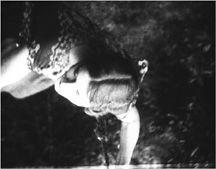
10.58
Ballet mécanique.
With these expectations set up in the short introductory section, the film goes on to vary its elements.
Segment 2
sticks fairly closely to the elements just introduced by beginning with another view of the shiny ball, now seen through a prism. There follow other shots of household objects, similar to the ball in that they are also shiny and are seen through a prism
(
10.59
).
Here is a good example of how a mundane object can be taken out of its everyday context and made abstract.
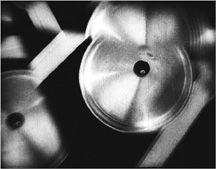
10.59 In
Ballet mécanique,
a prism shot is recognizable as a pot lid, its round shape picking up that of both the ball and the hat of the previous segment.
In the middle of the series of prism shots, we see a rapid burst of shots, alternating a white circle and a white triangle. This is yet another motif that will return at intervals, with variations. These shapes invite us to make comparisons: the pot lid is also round whereas the prismatic facets are somewhat triangular. During the rest of
segment 2
, we see more prism shots, interspersed with another rapid series of circles and triangles, followed by views of a woman’s eyes opening and closing, a woman’s eyes partially masked off by dark shapes
(
10.60
),
and finally the smiling/unsmiling mouth from
segment 1
.
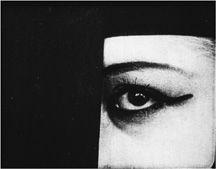
10.60 A masked shot in
Ballet mécanique.
Segment 2
has further confirmed our expectations that the film will compare shapes, rhythms, or textures. We also begin to see a pattern of surprising interruptions of the segments with bursts of brief shots. In
segment 1
, interruptions were created by shots alternating objects and a single triangle. Now we have twice seen a circle and triangle alternate. The rhythm of editing is as important as the rhythm of movement within individual shots for creating abstract relationships.
Ballet mécanique
provides a good example of how filmmakers may work outside the continuity editing system and create dynamic patterns of shots. One of the film’s funniest moments comes in
segment 2
and depends on a precise graphic match. We see an extreme close-up of a woman’s wide-open eyes
(
10.61
).
She closes them, leaving her eyeliner and brows as dark crescents against her white skin
(
10.62
).
A cut presents us with the same composition, now upside down (
10.62
). The eyes and brows are in nearly identical positions, but reversed. When the eyes pop open
(
10.63
),
we’re surprised to find their positions switched; quick cutting makes the match nearly indiscernible. Amusing touches like this make
Ballet mécanique
as enjoyable to watch today as it must have been when it was first shown 80 years ago.
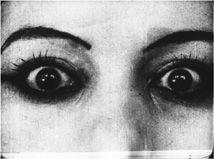
10.61
Ballet mécanique:
a shot of a woman with open eyes.
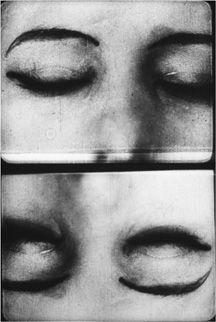
10.62 By the last frame of the same shot, her eyes are closed, and the first frame of the next shows her upside down.
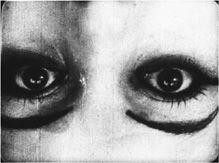
10.63 Later in the second shot, she opens her eyes.
Now that its basic patterns are well established, the film begins to introduce greater variations in order to play with our expectations.
Segment 3
begins with shots of rows of platelike discs, alternating with spinning shapes reminiscent of a fairground game wheel. Will round shapes and movements provide the main principle of development in this segment? Suddenly, the camera plunges down a twisting fairground slide. We see elements such as marching feet, cars going over the camera, and rapid shots of a carnival ride’s cars spinning past. Here different rhythms succeed one another, and common shape seems less important. Many of the objects are new ones, seen out of doors. Yet, after the carnival cars, we see a relatively lengthy shot of a spinning, shiny object—not in a prism view but at least recalling the image of the kitchen utensils seen earlier. The segment ends with the familiar rapid alternation of circle and triangle.
Segment 4
gives us the film’s most explicit comparison of humans and machines. We first see a carnival slide from above, picking up on an element from
segment 3
. The slide stretches horizontally across the screen, and in quick succession, a man’s silhouette whizzes down it four times
(
10.64
).
This may seem a continuation of
segment 3
’s concentration on rhythm, but next we see a machine part, strongly vertical on the screen
(
10.65
),
with a piston moving up and down rhythmically. Again we see similarities—a tubelike object with another object moving along it—and differences—the compositions use opposing directions, and the four movements of the man are shown in different shots, while the camera holds as the piston moves up and down within one shot. More shots compare the slide and machine parts, ending with one machine seen through a prism.
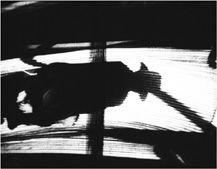
10.64 In
Ballet mécanique,
a strongly horizontal composition is contrasted with …
